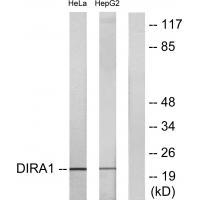
| WB | 咨询技术 | Human,Mouse,Rat |
| IF | 咨询技术 | Human,Mouse,Rat |
| IHC | 咨询技术 | Human,Mouse,Rat |
| ICC | 技术咨询 | Human,Mouse,Rat |
| FCM | 咨询技术 | Human,Mouse,Rat |
| Elisa | 咨询技术 | Human,Mouse,Rat |
| Aliases | GTP-binding protein Di-Ras1; Distinct subgroup of the Ras family member 1; Ras-related inhibitor of cell growth; Rig protein; Small GTP-binding tumor suppressor 1 |
| Entrez GeneID | 148252; |
| WB Predicted band size | 22kDa |
| Host/Isotype | Rabbit IgG |
| Antibody Type | Primary antibody |
| Storage | Store at 4°C short term. Aliquot and store at -20°C long term. Avoid freeze/thaw cycles. |
| Species Reactivity | Human |
| Immunogen | Synthesized peptide derived from C-terminal of human DIRA1. |
| Formulation | Purified antibody in PBS with 0.05% sodium azide. |
+ +
以下是关于DIRA(IL-1受体拮抗剂缺乏症)及其抗体治疗的3篇代表性文献,涵盖机制、临床治疗及综述:
---
1. **文献名称**:*An autoinflammatory disease with deficiency of the interleukin-1-receptor antagonist*
**作者**:Aksentijevich, I. et al.
**摘要**:本研究首次描述了DIRA的遗传机制,发现患者因IL1RN基因突变导致IL-1受体拮抗剂(IL-1Ra)缺乏,引发全身性炎症。研究通过病例分析证实了IL-1信号通路过度激活是疾病核心,为后续抗体靶向治疗奠定理论基础。
2. **文献名称**:*Autoinflammation due to mutations in IL1RN: Spectrum of disease manifestations*
**作者**:Reddy, S. et al.
**摘要**:通过多例DIRA患者临床数据,文章总结了疾病特征(如骨炎、皮疹),并报道使用重组IL-1Ra药物Anakinra治疗后症状显著改善,证实靶向IL-1通路的抗体疗法有效性。
3. **文献名称**:*IL-1 blockade in autoinflammatory syndromes*
**作者**:Jesus, A.A. & Goldbach-Mansky, R.
**摘要**:综述系统性探讨IL-1抑制剂(如Anakinra)在DIRA等自身炎症性疾病中的应用,强调早期诊断和抗体治疗对控制炎症、预防器官损伤的关键作用。
---
**备注**:DIRA治疗核心为补充IL-1受体拮抗剂(如Anakinra),而非直接使用“DIRA1抗体”。上述文献聚焦疾病机制及IL-1靶向疗法,如需更具体研究,可进一步检索近年关于IL-1抑制剂临床应用的更新进展。
DIRA1 antibody is associated with research on Deficiency of Interleukin-1 Receptor Antagonist (DIRA), a rare autosomal recessive autoinflammatory disorder caused by mutations in the *IL1RN* gene. This gene encodes the interleukin-1 receptor antagonist (IL-1Ra), a natural protein that inhibits pro-inflammatory signaling by blocking IL-1 receptors. In DIRA, loss-of-function mutations lead to unopposed IL-1-mediated inflammation, resulting in severe systemic inflammation, skin lesions, osteomyelitis, and bone deformities, typically presenting in infancy.
DIRA1 antibodies are primarily used in research and diagnostics to detect IL-1Ra protein levels or confirm its absence in suspected cases. They help differentiate DIRA from other IL-1-driven conditions, such as neonatal-onset multisystem inflammatory disease (NOMID). Additionally, these antibodies aid in studying disease mechanisms, including dysregulated IL-1 signaling pathways and inflammatory cascades. The development of DIRA1 antibodies has also supported therapeutic advancements, particularly in monitoring responses to recombinant IL-1Ra replacement therapy (e.g., anakinra), which dramatically alleviates symptoms. Their application underscores the importance of targeted immunotherapies in managing monogenic autoinflammatory disorders and highlights the role of precise biomarker detection in personalized medicine for rare diseases.
×